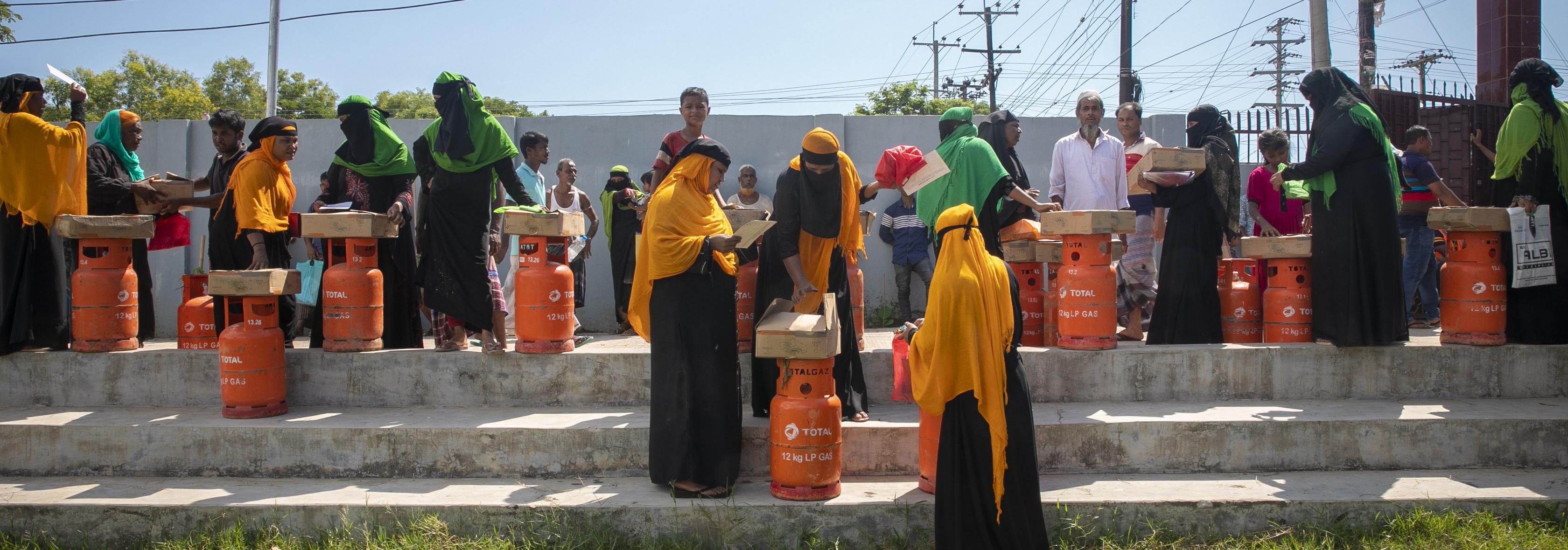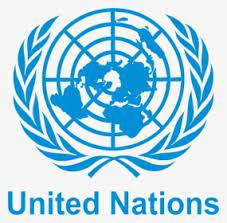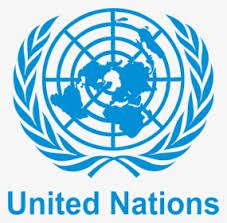IOM Vision
In 2020, IOM will continue to provide life-saving and sustaining assistance that meets the needs of Rohingya refugees in Cox's Bazar, while strengthening early recovery and preparedness initiatives to prevent further crises.
2020 will bring greater links with local partners through localization efforts and sustainability-driven development. IOM will extend and expand programming that addresses the concerns and vulnerabilities of host communities.
Objective
Saving lives and protecting people on the move
1,284,000 beneficiaries - 840,000 Rohingya refugees and 444,000 affected host community members.
Through health-related programming, IOM aims to assist 311,186 Rohingya and 156,972 host community individuals. To achieve this, IOM will:
- Improve equitable access to and the utilization of quality, lifesaving and comprehensive primary and secondary health services for all crisis-affected populations. This will include a special focus on sexual, reproductive, maternal, neonatal, child and adolescent health; mental health and psychosocial support (MHPSS); and non-communicable diseases.
- Ensure the prevention of and timely response to communicable disease risks, including those with an outbreak potential, and prepare for other health emergencies including those engendered by the monsoon and cyclone seasons.
- Encourage healthy living, improve health-seeking behaviour and the utilization of an essential service package among refugees and host populations through community engagement, with special attention to gender, age and vulnerable groups.
- Strengthen Health Sector coordination, information management and monitoring towards achieving rational, standardized and accountable health service delivery.
- Integrate MHPSS into primary health care at both health facility and community-level focusing on specialized care, community-based support structures and scaling up host community coverage for MHPSS services.
IOM applies a holistic protection response to the Rohingya and affected host communities and ensures protection is mainstreamed across all sectors. Through four key areas of protection programming (General Protection, GBV, Child Protection and Counter Trafficking) IOM aims to reach 188,261 beneficiaries in 2020 - 152,234 Rohingya and 36,027 host community members. Activities will include:
- General Protection: Implementing community-based protection, case management for extremely vulnerable individuals, protection monitoring and protection mainstreaming throughout IOM's engagements.
- Gender-based Violence (GBV): Improve quality service provision and systems strengthening between GBV and protection from sexual exploitation and abuse (PSEA) integration, improving GBV capacity of national authorities and scaling up existing women’s empowerment and self-reliance initiatives across new sites, including the regular operation of ten Women and Girls Safe Spaces (WGSS).
- Child Protection: Provide technical support and capacity building to community-based Child Protection Committees, Adolescents’ Committees and other related community groups to strengthen community-based child protection mechanisms. Provide case management and structured psychosocial support for child victims of abuse, neglect, violence and exploitation and at-risk children and their families through Child-Friendly Spaces, mobile activities and Child-Friendly Corners in WGSS.
- Counter-Trafficking: Continue awareness-raising programming, the provision of quality case management services to victims of trafficking, improving screening and identification techniques, and conducting assessments on human trafficking trends in 18 camps in Ukhiya and Teknaf, and 10 unions in host communities. Strengthen the government-led Counter-Trafficking Committees (CTC) and law enforcement through customized trainings and workshops, and the validation of relevant guidelines to identify and assist victims.
Through its water, sanitation and hygiene engagements, IOM aims to assist 288,413 beneficiaries in 2020 - 283,188 Rohingya refugees and 5,225 host community members. Activities will include:
- Improved Water Supply:
- Construct new solar-powered piped water networks (Camp 20, 20 Ext, and 23);
- Operate and conduct maintenance on existing tube wells (TW) and drill new TWs where needed;
- Ensure the operation, maintenance and monitoring of existing large-scale water networks (Camp 12/19 and Camp 24), as well as existing tube wells;
- Procure emergency stocks to prepare for cyclones or other natural disasters.
- Improved Sanitation and Waste Management:
- Construct and upgrade durable latrines that minimize desludging and health risks in both refugee and host communities;
- Construct new decentralized wastewater treatment systems (DEWATS) and upgrade older wastewater treatment systems and communal latrines;
- Construct additional bathing facilities and improve the drainage of existing facilities.
- Improved Hygiene Promotion and Epidemic Control:
- Provide critical supplies of hygiene items (soap, water containers, menstrual hygiene management (MHM) materials, etc.), together with community education and mobilization activities;
- Implement strong monitoring and community feedback mechanisms to ensure immediate identification and response for any water, sanitation and hygiene (WASH)-related health risks;
- Maintain emergency response stocks in case of any acute watery diarrhoea (AWD) or other outbreaks.
Through shelter-related programming, IOM aims to reach 489,781 beneficiaries - 422,581 Rohingya refugees and 67,200 host community members. Activities will include:
- Shelter Support:
- Continue the implementation of transitional shelter assistance (TSA) across the entire IOM Area of Responsibility (AoR) and the construction of mid-term shelters (MTS). TSA assistance includes the distribution of selected shelter materials, training and technical assistance to increase the durability of existing shelters. TSA will be implemented directly and through partners via the IOM-managed Shelter Sector Common Pipeline. The MTS, a 2-story and mezzanine shelter design, will be constructed through direct implementation and target the most vulnerable households.
- Set-up pilot studies to assess the suitability of alternative construction materials and community-led shelter interventions.
- Engage in capacity building of the refugee community on shelter and disaster risk reduction (DRR) measures to ensure beneficiaries are able make informed decisions on adequate and appropriate materials, construction techniques and prioritization of shelter upgrades. This will be achieved through targeting carpenters and selected groups/professions for a specialized Shelter-DRR training.
- Non-food Item (NFI) and Household-level Solar Light Provisions:
- Provide NFI assistance through a voucher system designed to strengthen the coping mechanisms of the Rohingya, considering their specific needs and cultural values, the environment, and the physical context.
- Provide solar lights for households.
- Host Community Support:
- Increase support to host communities, including through shelter construction and shelter repair assistance and provision of household-level lighting.
- Increase support to host communities, including through shelter construction and shelter repair assistance and provision of household-level lighting.
- Liquid Petroleum Gas (LPG) and Safe Cooking:
- Address the urgent cooking fuel needs of Rohingya refugees and host communities in Cox’s Bazar through the provision of LPG refills.
Site Maintenance and Engineering Project (SMEP)
The Site Maintenance and Engineering Project (SMEP) is a multi-agency partnership between IOM-UNHCR-WFP that addresses critical infrastructure needs in the Rohingya response. Through SMEP, as a component of IOM’s Site Management and Site Development Joint Response Plan, IOM aims to reach, both directly and indirectly, the entire projected beneficiary population in 2020—840,000 Rohingya refugees and 444,000 host community members. IOM will:
- Continue to undertake infrastructure inspection, repair, maintenance and installation of roads, drainage and slope stabilization. SMEP intends to use its machines, operating teams and experience to continue the development and maintenance of vehicle access roads and major drainage sites. This work will be complemented by additional small road and drainage installations to accommodate the massive changes in infrastructure in 2020.
- Undertake site preparation for new shelter plots.
- Conduct primary, secondary and roadside drainage; inspection, repair,
- maintenance, upgrade and installation.
- Secondary activities will include technical support to the Government of Bangladesh’s Local Government Engineering Department (LGED).
Site Management and Site Development (SMSD) and Communication with Communities (CwC)
As a component of IOM’s Site Management and Site Development Joint Response Plan, IOM aims to reach, both directly and indirectly, the entire projected beneficiary population in 2020 - 840,000 Rohingya refugees and 444,000 host community members. IOM will:
- Site Management and Site Development (SMSD):
- Strengthen community participation and inclusion by forming and strengthening AGD (aged, gender, diversity) groups while supporting them in designing and implementing community projects.
- Continue to support women in discussing, creating and implementing small scale projects of their own initiative (Women Participation Projects based on the UN Women's Empowerment, Participation and Leadership curriculum). IOM will foster collaboration and provide the necessary resources for women to actualize their project ideas.
- Harmonize the approach to community engagement, feedback and information dissemination within the IOM Area of Responsibility (AoR) between IOM and its partners.
- Strengthen representation committees within the IOM AoR and create legitimate representation structures wherever possible.
- Communicating with Communities (CwC):
- Continue to implement, strengthen and harmonize complaints and feedback mechanisms.
- Roll out a common system across the IOM AoR following trainings to the field teams and partners.
- Roll out the updated radio listening program called Aa’rar Hal Hobor which broadcasts community-driven and chosen information in a public and accessible manner.
Needs and Population Monitoring (NPM)
NPM will cover all camps and all unions in Teknaf and Ukhiya Upazilas covering a population of 1,284,000 beneficiaries—840,000 Rohingya refugees and 444,000 affected host community members. IOM will:
- Continue its support to different sectors, partners and IOM units with customized technical support for data collection and analysis that will provide an evidence-based approach for both IOM's interventions in 2020 and for use by the broader humanitarian community.
- Conduct two to three thematic pieces of research to support programmatic and operational decisions, determined through direct consultation with key stakeholders, and relevant working groups.
- Carry out unmanned aerial vehicle (UAV) flights covering all Rohingya refugee settlements to produce data for use in Site Assessments. The UAV imagery will be used to produce maps and digital elevation models for Site Management partners and operational actors, to monitor changes in site conditions and development.
- Conduct ad hoc rapid needs assessments for emergency event tracking in the case of displacement caused by evolving emergency scenarios.
IOM will support the staffing structure of the ISCG Secretariat. UNHCR, WFP, UNWomen, ACF and UNICEF currently contribute to the balance. The Secretariat will deliver the following key activities:
- Support Strategic Executive Group (SEG) and Head of Sub-Office (HoSO) efforts in taking decisions on key policy, security and operational challenges, informed by protection considerations;
- Manage the response program cycle needs overviews and analysis, strategic planning and appeals (including contingencies), and response and needs monitoring;
- Manage data and information in support of humanitarian decision-making, advocacy and public information, resulting in regular information products;
- Progress on a roadmap to localization, including building the capacity of national partners to ensure the sustainability of the response;
- Galvanize agency and sector capacity in gender and protection to ensure mainstreaming across the response during all stages of the programme cycle. The ISCG will continue to host the Gender Hub to provide technical support in gender mainstreaming across the response;
- Ensure adequate monsoon and cyclone preparedness and contingency planning with sectors and humanitarian partners;
- Reinforce field coordination mechanisms through the continued management of the humanitarian hub in Ukhiya, and support to Upazila level coordination.
Objective
Driving solutions to displacement
35,694 beneficiaries - 24,871 Rohingya refugees and 10,823 affected host community members.
Through livelihoods and social cohesion programming, IOM aims to engage approximately 35,694 beneficiaries in 2020 - 24,871 Rohingya refugees and 10,823 affected host community members. IOM will:
- Expand Skills Development Programs for 10,000 Individuals: Expand the implementation of the Women’s Income Generation Support (WINGS) program into ten more camps. Explore opportunities for other innovative economic initiatives that benefit both communities.
- Create more Training Centers and Social Events Hubs: Provide three multipurpose halls for youth and community engagement to promote unity, communal identity and positive life skills development.
- Strengthen Mechanisms for Community-Driven Safety and Security in Camps: Expand on the successful creation of three civil policing facilities by initiating two more in the remaining clusters of Camps 9 to 16.
- Community Restoration Projects: Promote collaborative approaches to dispute settlement and facilitate the rehabilitation/improvement of shared infrastructure through cash-for-work (CfW) schemes, increasing the opportunities for mutual dialogue, relationship development and the lowering of tension between communities.
- Conduct a Study on the Skills and Interests of Refugees: Conduct a study to map out current and potential skills development areas, including the needs of the host community populations.
- Capacity Building of Local Partners and Service Providers in Camps: Initiate a skills development consortium to provide a platform for capacity enhancement and adaptation to the needs of displaced populations.
Objective
Strengthen preparedness and reduce disaster risk
Disaster risk reduction measures have the capacity to benefit 45,000 beneficiaries, including Rohingya refugees and host community members.
Through this programming, beneficiaries will include six Union Disaster Management Committees (DMC) and four Upazila-level DMCs, 1,925 Cyclone Preparedness Programme (CPP) volunteers, 400 Fire Service and Civil Defense (FSCD) volunteers and four staff from the Bangladesh Meteorological Department (BMD). 45,000 persons will indirectly benefit from cyclone shelter preparedness measures. Activities will include:
- Capacity Development: Provide appropriate training to DMCs, CPP volunteers, FSCD volunteers and cyclone shelter committees.
- Infrastructure Rehabilitation: Rehabilitate and repurpose multipurpose cyclone shelters (currently used as schools) to host people in case of emergency. All roads leading to cyclone shelters will be repaired and nearby ponds cleaned.
- Equipment Support: Provide emergency kits to the FSCD and CPP. All cyclone shelters will be provided with emergency kits and assistive devices and wheelchairs for people living with disabilities.
- Emergency Operations Centre (EOC) Establishment: Extend EOCs to new Unions to strengthen the network’s operational capacity at the district-level for linking the flow of disaster information between critical response actors to monitor hazards and reduce risk.
- Strengthen Early Warning Systems: Engage with the general public, risk managers, community leaders, members of DMCs and Cyclone Shelter Management Committees to strengthen last mile connectivity in early warning systems with an emphasis on building the technical capacity of end-line users.
- Flood Preparedness and Mitigation: Capacitate DMCs with flood early warning signalling practices, rain gauges, tailored communication information and other mitigation tools.
- School Safety: Create and implement a comprehensive school safety plan, including evacuation plans and multi-hazards drills, through collaboration with local schools.
Bangladesh
The map used here is for illustration purposes only. Names and boundaries do not imply official endorsement or acceptance by IOM.
Figures are as of 31 December 2023. For more details of IOM's operational capacity in country, please see the IOM Capacity section.


















